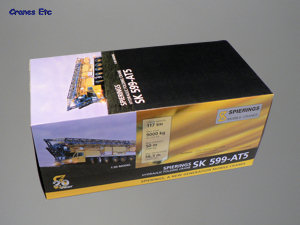 | | The picture box. | 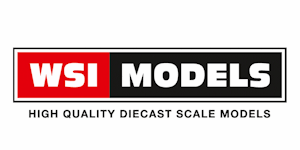 | 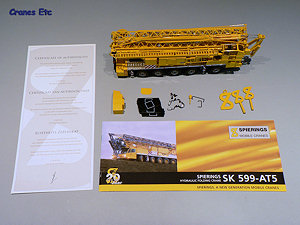 | | The parts out of the box including brochure and certificate of authenticity. | 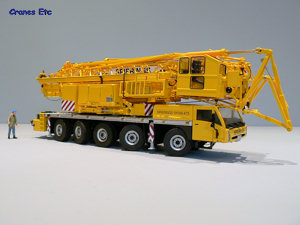 | | Another beacon light fits on the cabinet at the top of the mast, to the right of the crane cab. | 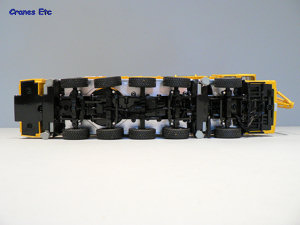 | | Underside view. | 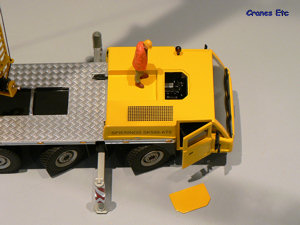 | | A hatch is removable to reveal engine detail. | 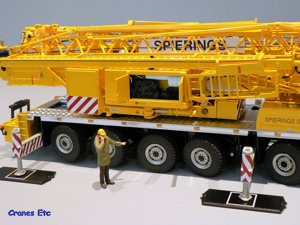 | | More opening doors into the crane engine compartment. | 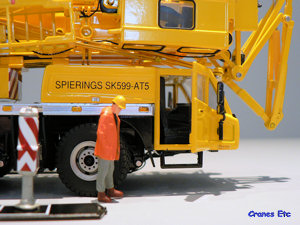 | | Opening cab doors. | 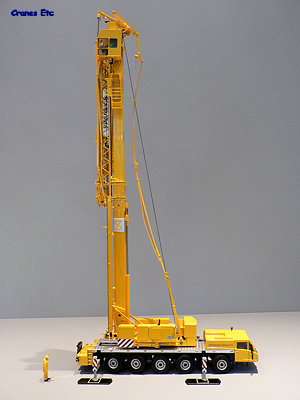 | | Mast partially extended. | 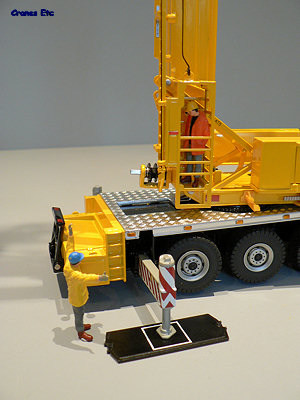 | | The working lift to the cab ready to go. | 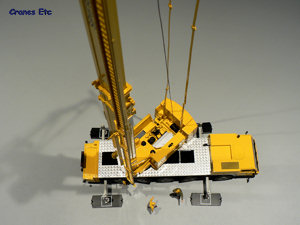 | | View from the top. | 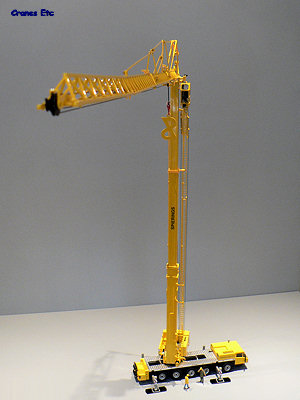 | | The jib opens to a realistic profile. | 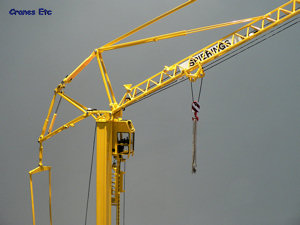 | | The jib can be set at a 30° angle. |
| Spierings Kranen BV is a Dutch company founded in 1987. It specialises in lorry-mounted tower cranes which have become increasingly popular due to their mobility and very fast set-up times on site which are typically only 15 minutes. These cranes are especially useful in urban environments where they are more efficient at lifting up and over existing buildings than conventional telescopic cranes. Spierings cranes can be found in Europe and Canada and the company continues to expand.
The SK599 AT5 is a 60 tonne five-axle crane that can lift a maximum of 9 tonnes, and 1.9 tonnes at the maximum radius of 50m. It can lift to a height of 32.6m and, with the jib raised at 30°, the maximum height is 56.3m. To see photos of the real machine click here.
This model has been released to celebrate the 20 year anniversary of Spierings and it is the first of a Spierings crane.
Packaging
The packaging is a conventional picture box enclosing a pair of expanded polystyrene trays containing the model which is well wrapped inside. Interestingly the box says that the model is not suitable for children under three years old. It certainly is not, and a complex model like this is really best suited as an 'adult' collectible. There were no defects or missing parts on the review model.
A brochure is provided with the model which includes technical specifications in English, Dutch and German. It also includes instructions which are good for showing how the model is assembled and disassembled. There are a number of small parts such as beacon lights which have to be fitted and the manual does not help with the location of these so the collector has to do it by inspection (see photos). It does not mention some of the other functions such as the working lift, nor how to set the jib to a luffed angle.
As expected for a model of this type, erecting and dismantling the model has to be carried out with care as it is a precision model with some delicately engineered parts. It is however fully reeved at the factory so this is one less task for the collector.
Also included is a Certificate of Authenticity and this appears to be individually initialled by Leo Spierings which is a very nice touch.
Detail
Commencing underneath, there is a very well detailed drive train with differentials and prop shafts which links the driven axles (2, 3, 4 and 5). There is also cabling running from the engine area and the suspension is modelled also. The wheels are mounted on realistic looking hubs with very good heavily patterned tyres. The vehicle appears to sit a little high on the wheels and some collectors have remarked on this. However in the UK there is at least one crane which has a configuration of wheels and tyres which make the model appear correct - see photos.
At the front the driving cab has headlights with tiny lenses and there are the usual windscreen wiper and wing mirrors, with a collector-fixed orange beacon light for the cab roof. Inside, the cab is well detailed with steering wheel, pedals and seats. Behind the cab is the engine compartment and this has some fine photo etched grille detail.
The carrier deck has a textured non-slip surface. Below this the outrigger beams and pads are all metal and are painted with hazard markings. A number of excellent rubber mud flaps protect the outriggers and these are all imprinted with the Spierings logo. At the rear there is a stowage area where four metal plates used for spreading the load under the outrigger pads are kept, and the provision of these is a welcome detail. A pull down rack is provided and painted light clusters and two collector-fitted orange beacon lights complete the detail.
The crane body sits on a large toothed slewing ring which is clearly visible. The body is very well detailed with tiny graphics which look authentic. Many of the smaller mechanical parts have been modelled in fine detail. Inside the engine compartment of the crane, the engine has been modelled complete with some cabling and the exhaust system. A compromise in the model is the provision of a separate counterweight block which can be fitted when the mast is raised as a way of helping the model to retain balance.
The mast section is a three stage telescope and all parts are metal with the exception of the collar on top of the second stage. The casting is good with plenty of structural detail. A three stage telescopic ladder is attached to the mast together with a lift cage which has some tiny operating notices attached. At the top of the mast is the operator’s cab and this is a superior piece of modelling with windscreen wipers, and a very well detailed cab interior including an electrical cabinet. A grille section acting as an entrance flap rests on the cab floor although it is not see-through like the real machine. Other detail at the mast top includes a collector-fitted orange beacon light and floodlight.
The mechanical linkages to the crane are almost entirely metal with the main exception being the plastic cylinder jackets on the jib luffing gear. The jib sections are all fully triangulated, and metal, and each of the four sections of jib appears to be made up of two castings – the top two sides is one piece and the underside is the other. The quality of manufacture here is good, so the jib sections are convincing. Fitted along the jib are a number of floodlights and these are each complete with tiny bulbs.
The trolley is metal, as is the hook block, and they both contain working pulleys.
Features
The steering works in linked pairs with all axles except axle 3 steering. The mechanism is very smooth and a good hard lock can be obtained which looks realistic. Each axle is independently sprung with suspension that works and this is very good indeed.
Both doors of the driving cab open and the hatch on the roof of the engine compartment is removable to allow the engine to be seen.
The outrigger beams extend and retract and can be screwed down, and this feature works without showing screw threads so is authentic looking. The provision of plates for the outriggers enables realistic poses to be obtained.
At the rear there is a folding rack which works and it can be lowered to provide additional carrying space.
The crane body features a pair of opening doors giving access to the crane engine, and the operator’s cab also has a working flap in the base which allows the operator to access the cab, although on the real crane this is located directly above the lift. Access to the cab is provided by means of a telescopic ladder and a lift. The telescopic ladder works well, extending as the mast is raised. The lift also works well and is operated using a winch at the mast top. It uses two guide strings to traverse up and down rather than using the ladder as a rail and as such this is a modelling compromise.
This is a very mechanically complex crane in real life and the model is similarly complex. Erecting the model however does not precisely replicate the original with certain connections having to be made by hand so it is not easy to pose the model in the erection stages of the original machine. Care is needed during the erection and dismantle operations as the mechanical parts are all a little delicate so at no time should the collector attempt to force anything. A pleasing feature is the swinging counterweight on the crane body which works very well.
The crane can be posed in travelling mode, or shown erected with either a horizontal or luffed jib at 30° to the horizontal. To achieve and hold the jib at an angle a clip is used. In fact a pair of black u-shaped clips is supplied, but only the smaller one is used with the clip being inserted at the luffing cylinders and this is an effective mechanism.
The crane functions all work with the crane turning smoothly and the hook being operated by means of the winch in the crane body although this can only be operated using the supplied key if the swinging counterweight is moved out of the way. A working trolley mechanism is also a welcome feature and it works well by using the key on the trolley motor.
Quality
This is a very good quality model. There is only a minimum of plastic used, and the quality of the metal castings is high. Paintwork and graphics are excellent.
The functionality of the model is very good and in fact the brochure supplied with the model probably undersells the model a little in this regard.
Price
The model offers a great deal for the money and in this context represents a very good value.
Overall
As a model celebrating Spierings' anniversary and as one of WSI’s first products both organisations can be pleased with the result. It is a very complex model mechanically and has been executed well. Detail and functionality are generally very good indeed.
There are some aspects which could be improved for future models but these do not detract much from the SK599. This is a precision model and will need to be treated with respect as it may be damaged with rough handling. In return though, it offers great display possibilities both in transport mode and, if you have the space, fully erected. The Spierings SK599 is an impressive attempt at a difficult modelling challenge.
Footnotes
The model appeared at the Bauma Equipment Exhibition in April 2007. Deliveries to customers commenced in September 2007. The following liveries have been produced: Model 9004 - Spierings yellow; Model 41001 - Mammoet, run of 1000; Model 9031 - Van der Tol;Model 9095 - Nederhoff; Model 9098 - Saan; Model 9105 - Herpertz; Model 9097 - Neeb.
|
| |
| 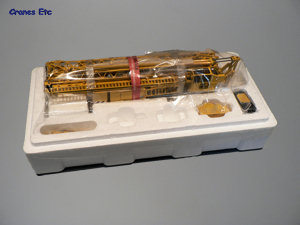 | | Inside the box. | 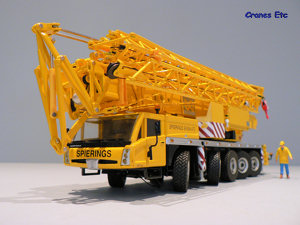 | | The front and rear pairs of axles steer well. One beacon light gets fitted above the cab door, and a floodlight gets fitted at the mast top (vertically above the first 'S' in Spierings in this photo). | 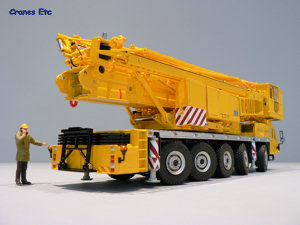 | | Rear view. | 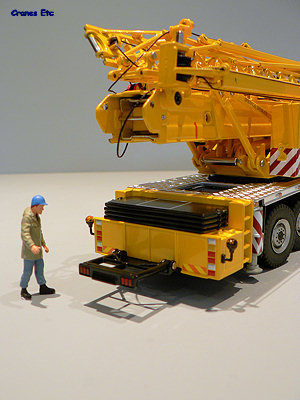 | | The outrigger pads are carried at the back. There is a fold-down extension deck also. | 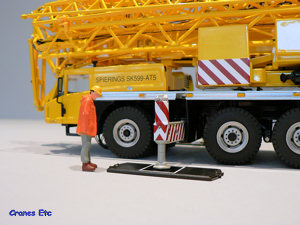 | | Outrigger beams are metal and no screw threads are visible. | 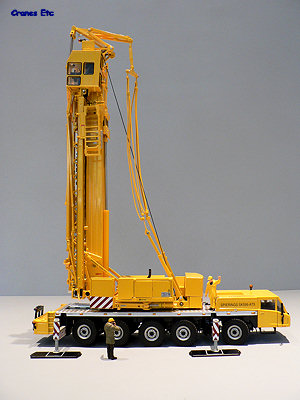 | | The mast raised vertical. | 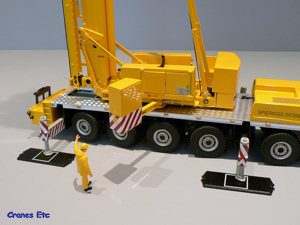 | | The swinging counterweight moves into position. The false counterweight provided with the model to aid stability is also shown fitted. | 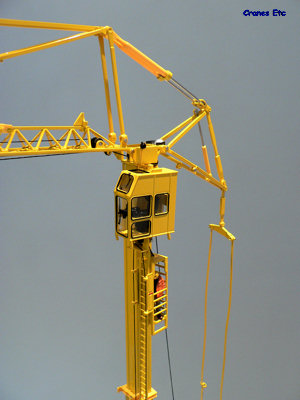 | | Lift nearly at the top. | 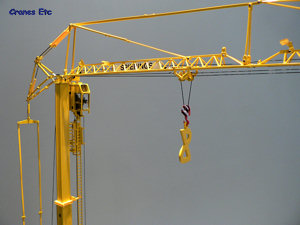 | | Crane ready to work. It is lifting a metal Spierings logo. | 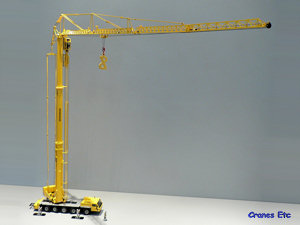 | | Fully set up, the model is large with a 1m jib. | 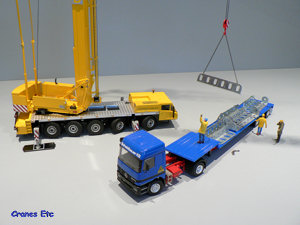 | | At work unloading some beams from a Talbert Trailer. |
|

